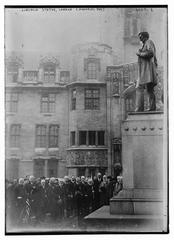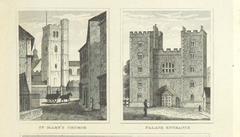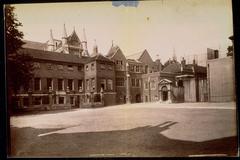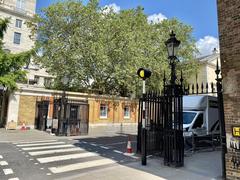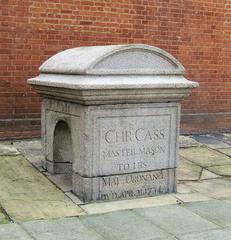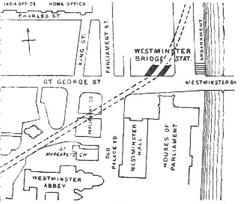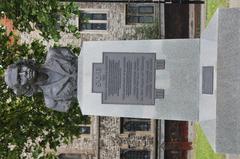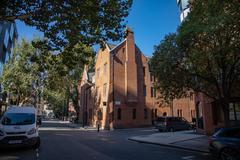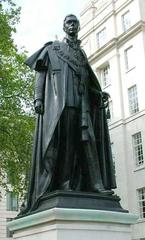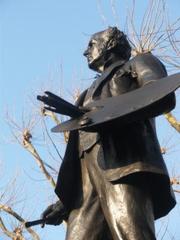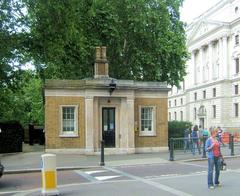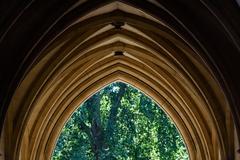The Boy David On The Chelsea Embankment
Visiting The Boy David on the Chelsea Embankment: London Guide
Date: 14/06/2025
Introduction
Nestled along the picturesque Chelsea Embankment, The Boy David statue stands as a powerful symbol of courage, sacrifice, and artistic heritage. Honoring the Machine Gun Corps (MGC) of the British Army, this evocative memorial merges biblical symbolism with poignant historical context. Set against the backdrop of the River Thames and the iconic Albert Bridge, the statue provides not only a site for remembrance but also a serene riverside experience within one of London’s most storied neighborhoods.
This guide explores The Boy David’s origins, artistic evolution, and enduring cultural significance, as well as practical visitor information—hours, accessibility, travel tips, and nearby attractions. Whether you are a history buff, art lover, or traveler seeking meaningful London landmarks, understanding The Boy David enriches your visit to Chelsea’s cultural landscape. For more on the memorial’s history, see London Remembers, Art UK, and the Imperial War Museums.
Table of Contents
- Introduction
- History and Origins of The Boy David Memorial
- The Memorial’s Artistic Evolution
- Symbolism and Significance
- Visiting Information: Hours, Accessibility, and Tips
- Nearby Attractions
- Frequently Asked Questions (FAQ)
- Preservation and Public Engagement
- Conclusion
- References
History and Origins of The Boy David Memorial
The Boy David memorial is intrinsically linked with the Machine Gun Corps (MGC), a pivotal British Army unit during World War I. Established in 1915, the MGC became emblematic of the mechanized warfare that defined the era, suffering heavy losses—over 12,000 men killed before the Corps was disbanded in 1922 (Wikipedia: Machine Gun Corps Memorial).
The original Boy David statue was created by Francis Derwent Wood, a sculptor and veteran of the war. Wood’s design, depicting a youthful and nude David after his victory over Goliath, was intended to evoke both the heroism and vulnerability of the Corps’ soldiers (London Remembers). The primary version of the statue, a 9-foot-tall bronze, was unveiled at Hyde Park Corner in 1925 and quickly became a focus of both admiration and controversy (Wikipedia: Machine Gun Corps Memorial).
A smaller, half-sized bronze Boy David was gifted to Chelsea in 1963, only to be stolen in 1969—prompting the borough to commission a replacement (London Remembers).
The Memorial’s Artistic Evolution
To replace the stolen statue, sculptor Edward Bainbridge Copnall was commissioned to create a new version. Copnall’s Boy David, installed in 1971, is cast in bronze-finished fibreglass—chosen for its resilience and lack of scrap value, deterring theft (Art UK). The figure stands atop a tall red granite column donated by Copnall himself.
The new statue features distinctive artistic choices: a nude male, with an oversized upper body and head, holds a downward-pointed sword and stands over Goliath’s head. The figure, about half life-size (122 cm tall), is set on a plinth 280 cm high. The statue’s elevated, smooth granite base further deters vandalism (Art UK; London Remembers). Plaques at the base recount the story of the Machine Gun Corps and the statue’s history (War Memorials Online).
Symbolism and Significance
David, the biblical underdog, symbolizes youthful courage, faith, and the triumph of intellect over brute force—echoing the experiences of the young machine gunners in World War I. The statue’s nudity highlights vulnerability, while the presence of Goliath’s head represents the cost of victory (London Remembers). Copnall’s modern idiom builds on Derwent Wood’s original emotional depth, while the use of fibreglass reflects evolving attitudes toward public art and memorialization (Art UK).
The statue’s riverside setting also places it within the tradition of Victorian and Edwardian public art, using sculpture to inspire reflection and civic pride along the Thames Embankment—a celebrated feat of 19th-century engineering (Grace’s Guide).
Visiting Information: Hours, Accessibility, and Tips
Hours and Admission:
The Boy David is outdoors in Chelsea Embankment Gardens and accessible 24/7, year-round. There is no admission fee.
Accessibility:
The memorial is on a raised plinth in a level, paved riverside garden. The surrounding area is wheelchair- and stroller-accessible; however, the statue itself is elevated and not physically accessible.
Getting There:
- Underground: Sloane Square or South Kensington (both about a 15-minute walk)
- Bus: Multiple routes along Chelsea Embankment and King’s Road
- Cycling: Bike lanes and Santander Cycles stations nearby
- Parking: Limited and expensive—public transport is recommended
Tips:
- Visit during daylight for best viewing and photos; early mornings and evenings offer beautiful Thames light.
- Combine your visit with a riverside walk or self-guided tour of Chelsea.
- The embankment is generally safe and well-lit, but standard urban precautions apply.
Photography:
Excellent photo opportunities abound, with the Thames, Albert Bridge, and Chelsea’s historic buildings as backdrops. Early morning and late afternoon light are ideal.
Events:
While there are no regular guided tours for the memorial, it is included in some Chelsea history and WWI walks. Annual commemorations by the Machine Gun Corps Old Comrades Association take place each May and on Remembrance Sunday.
Nearby Attractions
- Albert Bridge: Iconic pastel-hued suspension bridge, illuminated at night.
- Chelsea Physic Garden: One of London’s oldest botanical gardens.
- Royal Hospital Chelsea: Historic home to the Chelsea Pensioners.
- Battersea Park: Expansive park with gardens, lake, and Peace Pagoda, just across the river.
- Cheyne Walk: Noted for historic houses and literary blue plaques.
For more on local walks and attractions, see A Lady in London and That Girl Outdoors.
Frequently Asked Questions (FAQ)
Q: Are there entry fees or tickets for The Boy David?
A: No, the memorial is free and open to the public at all times.
Q: Is the site wheelchair accessible?
A: Yes, the embankment is level and accessible, though the statue itself is on a raised plinth.
Q: Are there guided tours?
A: While there are no tours dedicated solely to The Boy David, it features in several Chelsea and Thames Path walking tours.
Q: When is the best time to visit?
A: Daytime for safety and clear views; early mornings and evenings for photography.
Q: What nearby sites should I see?
A: Albert Bridge, Chelsea Physic Garden, Royal Hospital Chelsea, and Battersea Park.
Preservation and Public Engagement
The memorial is maintained by the Royal Borough of Kensington and Chelsea, with ongoing efforts to preserve its structure and educational plaques (Art UK). The site is a focal point for remembrance and community events, particularly during Armistice and annual MGC commemorations.
Conclusion
The Boy David on Chelsea Embankment is a compelling intersection of art, history, and remembrance. Combining evocative sculpture, rich symbolism, and an idyllic riverside setting, the memorial offers a meaningful destination for reflection and exploration. Accessible and free to all, it stands as a testament to youthful valor and the enduring legacy of the Machine Gun Corps.
Plan your visit to The Boy David, and immerse yourself in Chelsea’s vibrant history—whether you’re seeking a contemplative walk, world-class art, or connections to London’s wartime past.
Plan Your Visit & Stay Connected
- Download the Audiala app for curated audio tours and up-to-date visitor information.
- Explore our related guides on Chelsea’s landmarks and war memorials.
- Follow us on social media for event updates and insider tips.
References
- Machine Gun Corps Memorial, Wikipedia
- Boy David Memorial, London Remembers
- The Boy David, Art UK
- Machine Gun Corps Memorial, War Memorials Online
- Chelsea Embankment, A Lady in London
- Battersea Park Walk, That Girl Outdoors
- The Boy David Statue, Imperial War Museums
- Thames Embankment, Grace’s Guide
- Chelsea History, Local Histories
- Fantasies in Granite, Literary London Journal
- Chelsea Guide, Things To Do In London
Images:
- “Boy David Memorial on Chelsea Embankment, a tribute to the Machine Gun Corps”
- “Chelsea Embankment Gardens riverside promenade near Boy David Memorial”
